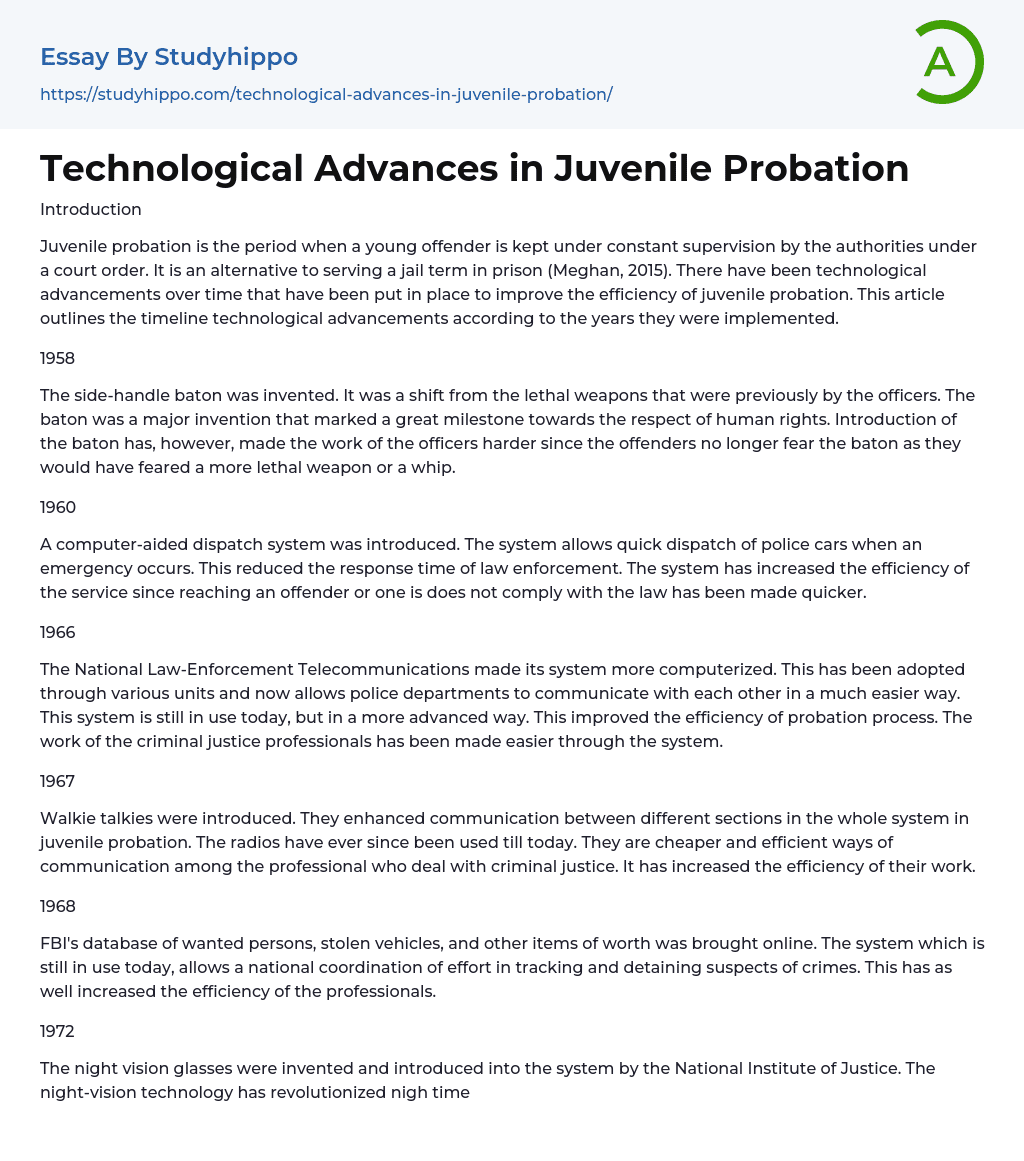

Technological Advances in Juvenile Probation Essay Example
Introduction
Juvenile probation is the period when a young offender is kept under constant supervision by the authorities under a court order. It is an alternative to serving a jail term in prison (Meghan, 2015). There have been technological advancements over time that have been put in place to improve the efficiency of juvenile probation. This article outlines the timeline technological advancements according to the years they were implemented.
1958
The side-handle baton was invented. It was a shift from the lethal weapons that were previously by the officers. The baton was a major invention that marked a great milestone towards the respect of human rights. Introduction of the baton has, however, made the work of the officers harder since the offenders no longer fear the baton as they would have feared a more lethal weapon or a whip.
1960
A computer-aided dispatch
...system was introduced. The system allows quick dispatch of police cars when an emergency occurs. This reduced the response time of law enforcement. The system has increased the efficiency of the service since reaching an offender or one is does not comply with the law has been made quicker.
1966
The National Law-Enforcement Telecommunications made its system more computerized. This has been adopted through various units and now allows police departments to communicate with each other in a much easier way. This system is still in use today, but in a more advanced way. This improved the efficiency of probation process. The work of the criminal justice professionals has been made easier through the system.
1967
Walkie talkies were introduced. They enhanced communication between different sections in the whole system in juvenile probation. The radios have ever since been used till
today. They are cheaper and efficient ways of communication among the professional who deal with criminal justice. It has increased the efficiency of their work.
1968
FBI's database of wanted persons, stolen vehicles, and other items of worth was brought online. The system which is still in use today, allows a national coordination of effort in tracking and detaining suspects of crimes. This has as well increased the efficiency of the professionals.
1972
The night vision glasses were invented and introduced into the system by the National Institute of Justice. The night-vision technology has revolutionized nigh time surveillance and combat. It has allowed clear vision at night without attracting attention with visible light.
1993
Police departments incorporated the use of computers enhancing budgeting, criminal investigation methods, allocation of tasks and storage juvenile information. The move reduced the procedures of admission and release of the juveniles. The same reduced the number of personnel required in the sector.
1996
The use of the double helix DNA was optimized in a move to improve the methods used for investigating juvenile cases. The use of the double helix provided undisputed evidence and therefore the culprit could in no way deny doing an assault. The method improved the evidence presented in courts to incriminate the suspects. Matching DNA of the suspect and that obtained from a crime scene is enough evidence.
2000
GPS monitoring is used in most juvenile cases. It involves the installation of a tracker on the offender to ascertain what they are doing and where they are at a given time. Introduction of the GPS has helped a lot to locate the whereabouts of the juveniles under probation.
2006
A sex offender public database was created to identify any
person including juveniles who was a sex offender. The database was meant to enhance child protection from sex offenders. The database at the same time helped to identify missing or noncompliant sex offenders easily. The database is still in use today and is used to monitor the young offenders. It has improved the work of the criminal justice professionals.
2008
Video surveillance was adopted. The videos are used to patrol around wide areas. Offenders are easily identified using the cameras and are arrested. This improved the national security and as well as that of the victims. Crime rates have dropped significantly after the installation. The data gotten from the camera footages are used in court as evidence against the offenders in any secondary charges
Reference
- Meghan L. (2015) Youth in probation: Focus on Criminal Justice. Print.
- Jurisprudence essays
- Juvenile Justice essays
- Social Injustice essays
- Animal Cruelty essays
- Charles Manson essays
- Crime Prevention essays
- Crime scene essays
- Criminal Justice essays
- Criminology essays
- Cyber Crime essays
- Damages essays
- Detention essays
- Distracted Driving essays
- Drug Trafficking essays
- Drunk Driving essays
- Forensic Science essays
- Gang essays
- Hate Crime essays
- Homicide essays
- Identity Theft essays
- Juvenile Crime essays
- Juvenile Delinquency essays
- Juvenile Justice System essays
- Law Enforcement essays
- Murder essays
- Organized Crime essays
- Penology essays
- Piracy essays
- Prison essays
- Property Crime essays
- Prostitution essays
- Punishment essays
- Punishments essays
- Rape essays
- Robbery essays
- Serial Killer essays
- Sexual Assault essays
- Sexual Assault on College Campuses essays
- Sexual Harassment essays
- Sexual Offence essays
- Stealing essays
- Surveillance essays
- Ted Bundy essays
- Victim essays
- Violent crime essays
- White Collar Crime essays



